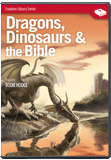A Living Dinosaur?
Originally published in Creation 23, no 1 (December 2000): 56.
According to a report in Papua New Guinea's The Independent newspaper, a 'dinosaur-like reptile' was seen on two occasions in the Lake Murray area, in Western Province.
On December 11, 1999, villagers travelling in a canoe reported seeing the creature wading in shallow water near Boboa.
The following day, a Seventh Day Adventist pastor and a church elder say they saw the animal not far from the first sighting.
The creature was described as having a body 'as long as a dump truck' and nearly two metres wide, with a long neck and a long slender tail. It was walking on two hind legs 'as thick as coconut palm tree trunks', and had two smaller forelegs. The head was similar in shape to a cow's head, with large eyes and 'sharp teeth as long as fingers.' The skin was likened to that of a crocodile, and the creature had 'largish triangular scoops on the back.'
Its large size and crocodile-like skin certainly bring images of dinosaurs powerfully to mind.
So what did these eyewitnesses really see? The description does not seem to fit any species known to live on the earth today. However, its large size and crocodile-like skin certainly bring images of dinosaurs powerfully to mind.
The circumstances in which it was encountered are strikingly reminiscent of the river-dwelling sauropod-like animal known as mokele-mbembe, whose sightings in the vast, remote swamps of Africa's Congo region have led even some evolutionist scientists to speculate that dinosaurs may still be living in the world today.2
For believers in the prevailing evolutionary view that dinosaurs died out 65 million years ago, the idea that they might be alive today is hard to accept. This is despite the recent discovery of the living Wollemi pine tree,3 also believed, from fossils, to have been extinct since the 'dinosaur age'.
Christians, however, should not be surprised, as the Bible teaches that God created the dinosaurs only thousands of years ago.
So why have dinosaurs (apparently) disappeared? Probably for the very same reasons that wildlife protection agencies give when expressing concern over current extinction rates of animals and plants,4 primarily the effect of man (e.g. through hunting and land clearing).
After the Flood, many of the dinosaurs and other animals are likely to have multiplied across the earth (Genesis 8:17) more quickly than Noah's descendants (e.g. a rabbit's pregnancy lasts 31 days; the offspring mature in ten weeks). N.B. also that the people disobediently stayed around Babel, before God judged them.
As human settlement expanded, populations of many animal species would have declined due to over-exploitation (for meat, skins, etc.), habitat loss, or deliberate extermination to reduce the threat of attack. Tales of dragon-slaying heroes like St George may suggest man's part in the dinosaurs' demise.
Despite the popular view that such factors have the most impact on amphibians (e.g. frogs), many scientists now recognise that reptiles are in even greater danger of extinction.5 This may help to explain why the celebrated dinosaurs have apparently died out before many of our so-called 'modern' species.
So if any dinosaur species are still living, the most likely places to find them would be in biologically rich areas with limited or no human settlement, such as the Congo and Lake Murray regions, as these reports suggest.
References
- The Independent (Papua New Guinea), December 30, 1999, p. 6.
- See Mokele-mbembe: a living dinosaur? Creation 21(4):24–25, 1999.
- See Sensational Australian Tree . . . Like “Finding a Live Dinosaur”, Creation 17(2):13, 1995; Creation19(3):7, 1997.
- Estimated extinction rates vary wildly, from 1-50 species per day. Myers, N., 'What we must do to counter the biotic holocaust', <www.nationalwildlife.org/nwf/intlwild/1998/holocaust.html>, September 15, 2000.
- UniSci (Daily University Science News), <www.unisci.com/stories/20003/0814004.htm>, August 15, 2000.
Recommended Resources

Answers in Genesis is an apologetics ministry, dedicated to helping Christians defend their faith and proclaim the good news of Jesus Christ.
- Customer Service 800.778.3390
- © 2025 Answers in Genesis






